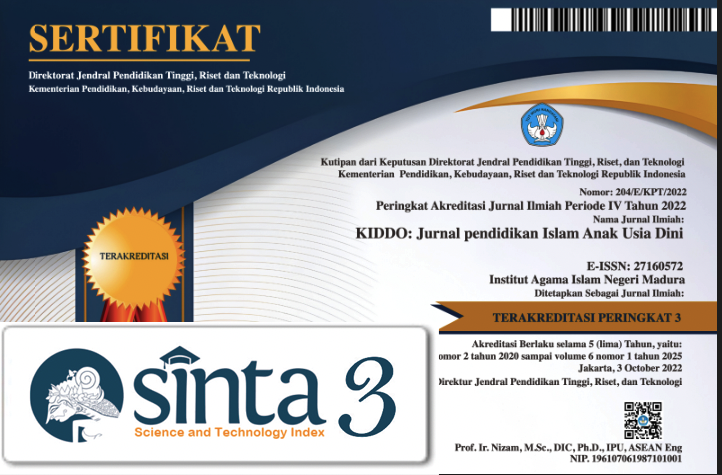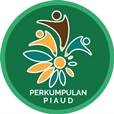Diffusion of 3-D Quiver Application Innovation Based on Augmented Reality Technology at Early Childhood Education Institutions
 Abstract views: 875
,
Abstract views: 875
,
 PDF downloads: 755
PDF downloads: 755
Abstract
This innovation diffusion research aims to disseminate innovative applications containing Augmented Reality (AR) technology in Early Childhood Education institutions through coloring activities in developing children's creativity. Because every child has talent and creativity that must be welcomed through various activities that can help their development. It is important for children in their learning environment to be given the opportunity to explore multi-media in order to realize the fertilization of their creative potential. Children's interest in digital devices can be used as a great opportunity for teachers in utilizing media and learning resources in early childhood education institutions. Augmented Reality (AR) technology content contained in the Q-3D Application in coloring activities provides an interesting offer by presenting virtual world visual images formed in 3-D animation into a real environment with the help of smartphones for images created and colored, so as to develop their creativity. In this innovation diffusion research, the descriptive analysis method is used with two approaches, namely: qualitative and quantitative. The data were obtained through three methods, namely: observation, interview, and documentation. Innovation diffusion research provides important findings that the level of adopter acceptance of the innovation of the Aaugmented Reality-based Quiver 3D app is very high and children's creativity is well developed.
Downloads
References
Adamenko, N., Oblova, L., Aleksandrova, O., Khrypko, L., Maksymets, O., Pasko, K., & Ishchuk, A. (2021). Human Identity As Freedom Statement in the Philosophy of Child Education. Wisdom, 20(4), 113–125. https://doi.org/10.24234/wisdom.v20i4.538
Azuma, R. T. (2017). Making Augmented Reality a Reality. Optics InfoBase Conference Papers. https://doi.org/10.1364/3D.2017.JTu1F.1
Balandin, S., Oliver, I., Boldyrev, S., Smirnov, A., Shilov, N., & Kashevnik, A. (2010). Multimedia services on top of M3 Smart Spaces. Proceedings - 2010 IEEE Region 8 International Conference on Computational Technologies in Electrical and Electronics Engineering, SIBIRCON-2010, 13(2), 728–732. https://doi.org/10.1109/SIBIRCON.2010.5555154
Bottani, E., & Vignali, G. (2019). Augmented reality technology in the manufacturing industry: A review of the last decade. IISE Transactions, 51(3), 284–310. https://doi.org/10.1080/24725854.2018.1493244
Ceruti, A., Marzocca, P., Liverani, A., & Bil, C. (2019a). Maintenance in aeronautics in an Industry 4.0 context: The role of Augmented Reality and Additive Manufacturing. Journal of Computational Design and Engineering, 6(4), 516–526. https://doi.org/10.1016/j.jcde.2019.02.001
Ceruti, A., Marzocca, P., Liverani, A., & Bil, C. (2019b). Maintenance in aeronautics in an Industry 4.0 context: The role of Augmented Reality and Additive Manufacturing. Journal of Computational Design and Engineering, 6(4), 516–526. https://doi.org/10.1016/j.jcde.2019.02.001
Chuang, H. M., & Shen, C. C. (2008). A study on the applications of learning paths concepts to the teaching in elementary school. Proceedings - 8th International Conference on Intelligent Systems Design and Applications, ISDA 2008, 2, 543–548. https://doi.org/10.1109/ISDA.2008.22
Cieza, E., & Lujan, D. (2018). Educational Mobile Application of Augmented Reality Based on Markers to Improve the Learning of Vowel Usage and Numbers for Children of a Kindergarten in Trujillo. Procedia Computer Science, 130, 352–358. https://doi.org/10.1016/j.procs.2018.04.051
Colmann, M., Abdullah, B., Samihah, C., Che, B., Sunar, M. S., Binti, A. R., & Yunos, A. M. (2016). Graphical Instruction for Coloring Mobile-Based Augmented Reality Applications. 2nd INTERNATIONAL CONFERENCE ON CREATIVE MEDIA, DESIGN & TECHNOLOGY (REKA2016).
Craft, A. (2005). Creativity in schools: Tensions and dilemmas. Creativity in Schools: Tensions and Dilemmas, January 2005, 1–192. https://doi.org/10.4324/9780203357965
Dash, A. K., Behera, S. K., Dogra, D. P., & Roy, P. P. (2018). Designing of marker-based augmented reality learning environment for kids using convolutional neural network architecture. Displays, 55, 46–54. https://doi.org/10.1016/j.displa.2018.10.003
Fatmawati, N., Kisno, K., Nawangsasi, D., & Ardiansyah, A. (2019). Pemanfaatan Aplikasi Quiver-3D Coloring Berbasis Augmented Reality dalam Pengembangan Kognitif Anak Usia Dini. November. http://repository.lppm.unila.ac.id/id/eprint/16384
Fernando Carrión Robles, V., Espinoza-Celi, A., & Vargas-Saritama. (2023). to Inspire Writing in an Ecuadorian EFL Distance Program. 13(5), 121–141.
Gecu-Parmaksiz, Z., & Delialioğlu, Ö. (2020). The effect of augmented reality activities on improving preschool children’s spatial skills. Interactive Learning Environments, 28(7), 876–889. https://doi.org/10.1080/10494820.2018.1546747
Ida, Umami; Uswatun, Hasanah; Kisno, K. dkk. (2022). MEDIA PEMBELAJARAN Konsep dan Aplikasi dalam Pengembangan Kreativitas dan Kemampuan Anak Usia Dini (Kapradja Sangadji; Much Deiniatur; Nia Fatmawati (ed.); Pertama). Pena Persada.
Jose A. Garcia-Aviles, Weil, A. R. (2018). Diffusion of innovation. Health Affairs, 37(2), 175–175. https://doi.org/10.1377/hlthaff.2018.0059
Karaarslan, S. V. (2018). Application of augmented reality technologies in archaeology. English Article, 2018, 181–200. http://www.arkeotekno.com/pg_305_application-of-augmented-reality-technologies-in-archaeology
Kisno, K., & Fatmawati, N. (2017). Peningkatan Hasil Belajar Matematika Melalui Penggunaan Media Audio-Visual. Pendas : Jurnal Ilmiah Pendidikan Dasar, 2(1), 99. https://doi.org/10.23969/jp.v2i1.500
Kisno, K., Wibawa, B., & Khaerudin, K. (2022a). Development of Digital Storytelling Based on Local Wisdom. Wisdom, 4(3), 65–74. https://doi.org/10.24234/wisdom.v4i3.834
Kisno, Wibawa, B., & Khaerudin. (2022b). Digital Storytelling for Early Childhood Creativity: Diffusion of Innovation “3-D Coloring Quiver Application Based on Augmented Reality Technology in Children’s Creativity Development". International Journal of Online and Biomedical Engineering, 18(10), 26–42. https://doi.org/10.3991/ijoe.v18i10.32845
Krevelen, R. Van, & Poelman Ronald. (2010). A Survey of Augmented RealityTechnologies, Applications and Limitations. International Journal of Virtual Reality, 9(2), 10–20. http://www.arvika.de/
Kuang, Y., & Bai, X. (2019). The feasibility study of augmented reality technology in early childhood education. 14th International Conference on Computer Science and Education, ICCSE 2019, Iccse, 172–175. https://doi.org/10.1109/ICCSE.2019.8845339
Long, H., Kerr, B. A., Emler, T. E., & Birdnow, M. (2022). A Critical Review of Assessments of Creativity in Education. Review of Research in Education, 46(1), 288–323. https://doi.org/10.3102/0091732X221084326
Lubart, T., Pacteau, C., Jacquet, A. Y., & Caroff, X. (2010). Children’s creative potential: An empirical study of measurement issues. Learning and Individual Differences, 20(4), 388–392. https://doi.org/10.1016/j.lindif.2010.02.006
Meade, N., & Islam, T. (2006). Modelling and forecasting the diffusion of innovation - A 25-year review. International Journal of Forecasting, 22(3), 519–545. https://doi.org/10.1016/j.ijforecast.2006.01.005
Monggilo, Z. M. Z. (2021). Cakap Bermedia Digital. http://literasidigital.id/books/modul-cakap-bermedia-digital/
Mota, J. M., Ruiz-Rube, I., Dodero, J. M., & Arnedillo-Sánchez, I. (2018). Augmented reality mobile app development for all. Computers and Electrical Engineering, 65, 250–260. https://doi.org/10.1016/j.compeleceng.2017.08.025
Nakevska, M., Sanden, A. Van Der, Funk, M., Hu, J., Nakevska, M., Sanden, A. Van Der, & Funk, M. (2017). activity on User Experiences Interactive Storytelling in a Mixed Reality Environment : The Effects of Interactivity on User Experiences. Entertainment Computing. https://doi.org/10.1016/j.entcom.2017.01.001
Ramli, A., Rahmatullah, R., Inanna, I., & Dangnga, T. (2018). Peran media dalam meningkatkan efektivitas belajar. Prosiding Seminar Nasional Lembaga Pengabdian Kepada Masyarakat UNM, 5–7. https://ojs.unm.ac.id/semnaslpm/article/download/7649/4429
Redondo, B., Cózar-Gutiérrez, R., González-Calero, J. A., & Sánchez Ruiz, R. (2020). Integration of Augmented Reality in the Teaching of English as a Foreign Language in Early Childhood Education. Early Childhood Education Journal, 48(2), 147–155. https://doi.org/10.1007/s10643-019-00999-5
Robertson, T. S. (1967). The Process of Innovation and the Diffusion of Innovation. Journal of Marketing, 31(1), 14. https://doi.org/10.2307/1249295
Sangadji, K., Sangadji, B., & Kisno. (2022). Teacher Professional Practical Training Module for Teachers Assistant in Guiding Practice Students in Managing Learning. Journal of Education Technology, 6(3), 531–541. https://doi.org/10.23887/jet.v6i3.45996
Santi, G. M., Ceruti, A., Liverani, A., & Osti, F. (2021). Augmented Reality in Industry 4.0 and Future Innovation Programs. Technologies, 9(2). https://doi.org/10.3390/technologies9020033
Sartipi, F. (2020). Diffusion of Innovation Theory in the Realm of Environmental Construction. Journal of Construction Materials, 1(4). https://doi.org/10.36756/jcm.v1.4.2
Simões, T. C. (2018). Exploring an approach based on digital games for teaching programming concepts to young children. https://doi.org/10.1016/j.ijcci.2017.12.005
Syafitri, D., Saputri, C., & Bumigora, S. (2016). Perancangan Media Pembelajaran Berbasis Augmented Reality Pada Pelajaran Bahasa Inggris Untuk Meningkatkan Penguasaan Kosa Kata Dan Hasil Belajar. 28–29.
Syawaludin, A., Gunarhadi, & Rintayati, P. (2019). Development of augmented reality-based interactive multimedia to improve critical thinking skills in science learning. International Journal of Instruction, 12(4), 331–344. https://doi.org/10.29333/iji.2019.12421a
Tao, F., Sui, F., Liu, A., Qi, Q., Zhang, M., Song, B., Guo, Z., Lu, S. C. Y., & Nee, A. Y. C. (2019). Digital twin-driven product design framework. International Journal of Production Research, 57(12), 3935–3953. https://doi.org/10.1080/00207543.2018.1443229
Vallino, J. R., & Brown, C. M. (1998). Interactive Augmented Reality.pdf. Department of Computer Science.
Veronika Karnowski, A. S. K. (2016). Diffusion of Innovations von Everett M. Rogers (1962). Schlüsselwerke Der Medienwirkungsforschung, 1962, 98.
Wang, L. (2019). Creativity as a pragmatic moral tool. Journal of Business Research, 96(September 2017), 1–13. https://doi.org/10.1016/j.jbusres.2018.10.009
Weil, A. R. (2018). Diffusion of innovation. Health Affairs, 37(2), 175–175. https://doi.org/10.1377/hlthaff.2018.0059
Wibowo, I. T. (2019). Proses Difusi Inovasi Program Sistem Aplikasi Keuangan Tingkat Instansi (Sakti) : Studi Kasus Pada Ditjen Perbendaharaan Di D.I. Yogyakarta Tahun 2018. Indonesian Treasury Review, 4(4), 323–337.
Yildirim, A. (2010). Creativity in early childhood education program. Procedia - Social and Behavioral Sciences, 9, 1561–1565. https://doi.org/10.1016/j.sbspro.2010.12.365
Yilmaz, R. M. (2016a). Educational magic toys developed with augmented reality technology for early childhood education. Computers in Human Behavior, 54, 240–248. https://doi.org/10.1016/j.chb.2015.07.040
Yilmaz, R. M. (2016b). Educational magic toys developed with augmented reality technology for early childhood education. Computers in Human Behavior, 54, 240–248. https://doi.org/10.1016/j.chb.2015.07.040
Copyright (c) 2023 Kisno K

This work is licensed under a Creative Commons Attribution 4.0 International License.
-
The journal operates an Open Access policy under a Creative Commons 4.0 International license. The terms of the license are:
Share— copy and redistribute the material in any medium or format
Adapt— remix, transform, and build upon the material for any purpose, even commercially.
1. Authors retain copyright and grant the journal right of first publication with the work simultaneously licensed under a Creative Commons License.that allows others to share the work with an acknowledgement of the work’s authorship and initial publication in this journal
2. Authors are permitted and encouraged to post their work online (e.g., in institutional repositories or on their website) prior to and during the submission process, as it can lead to productive exchanges, as well as earlier and greater citation of published work (See The Effect of Open Access).
Jurnal Kiddo is licensed under a Creative Commons
n Access).














